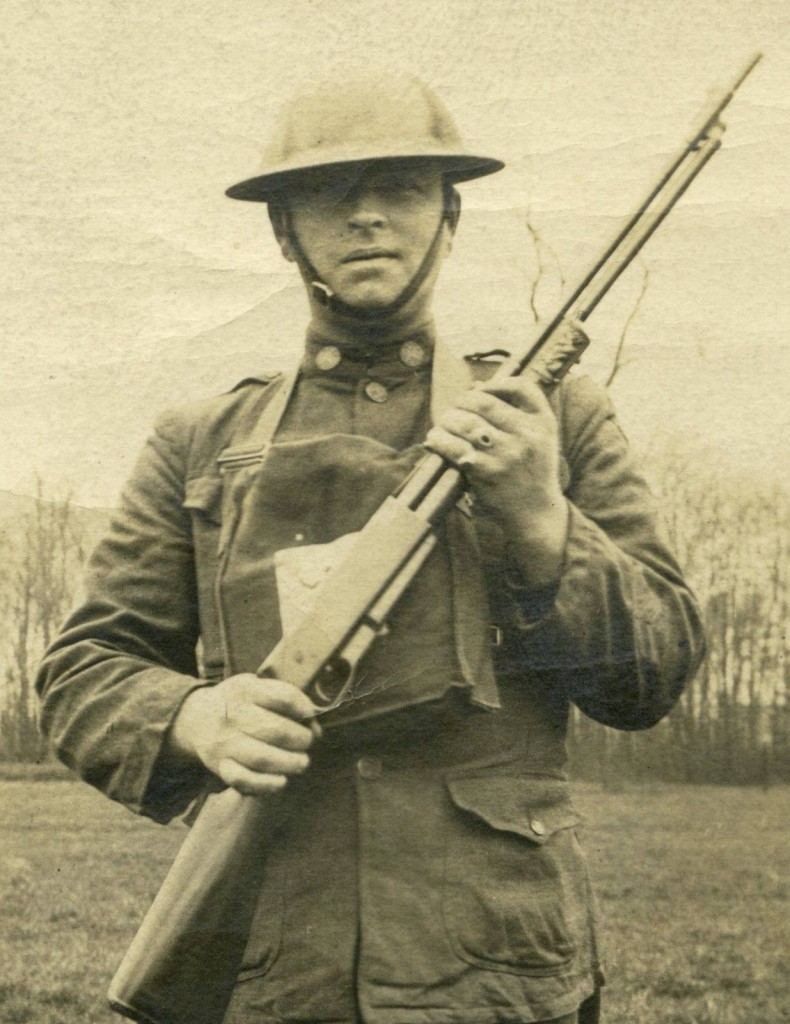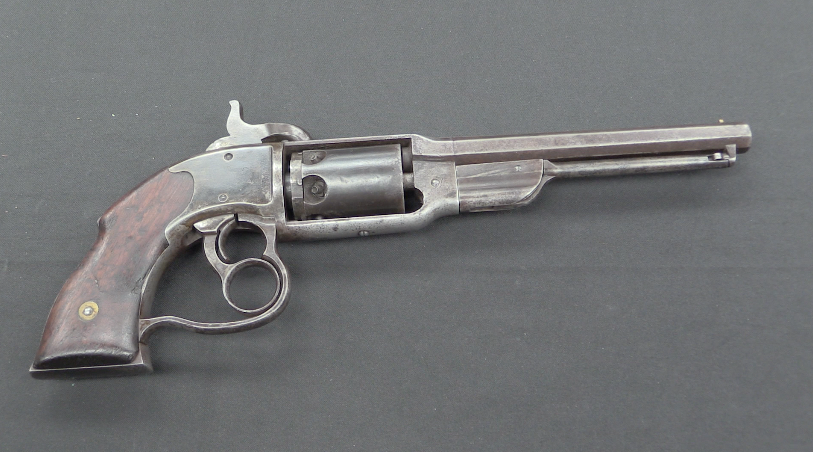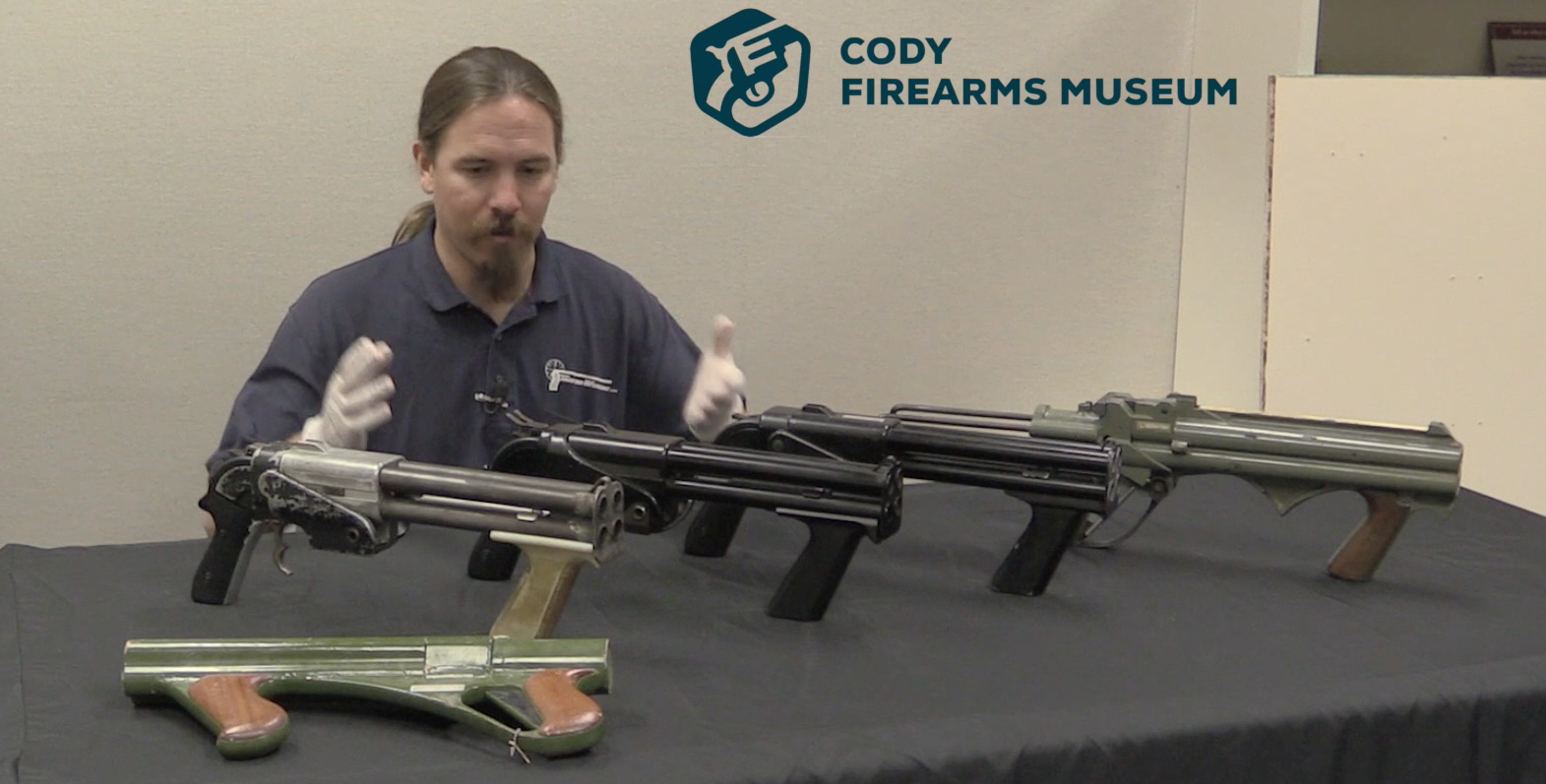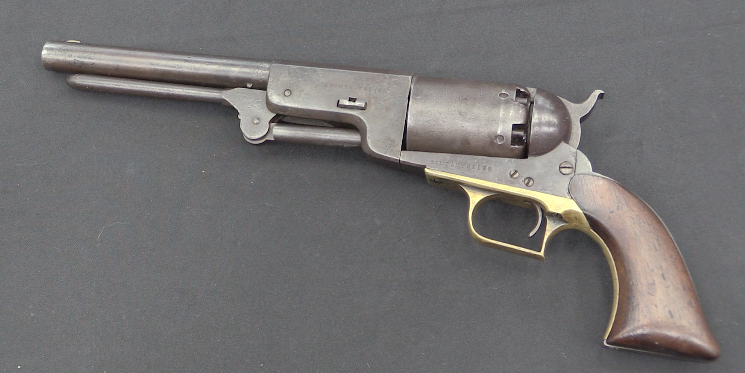
A postcard photo from May 1918 (sent to me by Shane M. – thanks, Shane!). Featuring Arthur L. Potts, 103rd MG Co. 26th Division. The Standard Arms Model G rifle he’s holding was a direct competitor to the Remington Model 8 and Winchester 1905/1907 Self-Loaders – and it was a commercial flop largely due to parts breakage. It would be interesting to know the context of the photo, as these rifles were not used by the military. I have a video coming up in a couple weeks on the Model G…




This guy will likely have the gun break and then he’ll grab up a Springfield or Enfield from a dead guy!
I’m guessing that the Model G really needed some fixes in design and better metallurgy. Just dump the gas valve and have this operate as a semi-auto!
The Standard Arms replace the Model G semi-auto with Model M repeating rifle which was Model G without semi-auto ability – it was pump-action only.
26th Infantry Division, U.S. Army;
If this photo was taken in May 1918, it must have been taken in France, as that’s where the 26 ID was. They relieved the 1 ID at St. Mihiel in the first week of April, and remained in the Apremont, Xivray-Marvoisin, Seicheprey, Bois de Remieres area until relieved by the 82 ID on 5 July. They repulsed several German attacks while in the line.
Exactly what a Standard Model G was doing there is a pretty good question. It chambered no standard service round (they were only made in 25, 30, and 35 Remington, rounds in the general power level of the .30-30 WCF), and it was only made for 3 years from 1909 to 1912.
It was very likely Mr. Potts’ personal rifle, but why bring it to France? Other than a strange desire for an Article 15, I mean.
cheers
eon
Was the rifle ever exported to France or Germany? I mean, could he have acquired it locally in France?
I actually -have- a model G.in .35 remington. It’s in my father’s gunsafe. I’ll have to see about getting it back
I wonder if the “May 1918” date is actually correct. Both the rifle and Mr. Potts appear to be quite clean, and without the usual signs endemic to front-line warfare. Also, the trees and terrain in the background appear to be pristine and show no indications of artillery damage, trenching, fortification or the sort of wear and tear associated with long-term military occupancy. In addition, there appear to be hills in the background reminiscent of the terrain typical to New England. I’m guessing this photograph might actually have been taken in New England prior to shipping overseas, although there is a somewhat remote outside possibility that it was taken in a rear area in France prior to moving forward into the lines.
I looked up the photo, and one seller claims that the weapon is a shotgun. This is most probably simply said seller demonstrating their ignorance of small arms, but
Emphasis mine.
0.50 inch is called 32-gauge in Europe, aka 14mm shotshell, and was still popular there until the 1980s. 32 gauge was a fairly common size in France before WW1. If (I admit, a big one) this is a Standard Camp Gun shotgun in 32-gauge, not a rifle, its presence may be explained as being a local acquisition in France.
For that matter, in both World Wars, shotguns were used by the U.S. Army and Navy in training machine gun units in the correct way to “lead” an aerial target in AA fire.
So, it’s just possible that a Standard Camp Gun might have been one used is such training by the machine gun units of the 26 ID on the basis of it being a shotgun, and both it and ammunition for it being available in that time and place.
Yes, this is guesswork. But like any good student of the Canon, I use Watson’s methods as I would not dare to arrogate unto myself the techniques of the Master.
cheers
eon
“0.50 inch is called 32-gauge in Europe, aka 14mm shotshell”
Can you point to any reliable source concerning shotgun gauges? I have doubts: the 14mm equals 0.55″ and 0.50″ equals 12.7mm, what is true bore? I know that some cartridge was (for example .38 Super is .356) and is (for example .327 Federal is .312) designated with false bullet diameter?
Even if the bore was same there also two other things which much be considered:
-length of shotshell – have “European” and “American”
-powder charge – crucial due to fact that it was self-loading fire-arm
On the other hand I’m wondering about Standard Arms self-loading shotgun reliability, the shotshell due to their shape can cause some jams which can’t be made by cartridge from Remington (Autoloading) line.
Shotshell must be (due to their shape) placed more precisely to go into chamber – Remington Autoloading cartridges can be placed less precisely due to their bottleneck shape. Also the rim of shotshell might lead to malfunction (jamming magazine).
is: “have “European” and “American””
should be: “have “European” and “American” equal length?”
Cartridges of the World, 6th edition, 1989, by Frank C. Barnes. Chapter 10, “Shotgun Shells, Current and Obsolete, Black Powder and Smokeless”, pp.374-393.
Re the 32 gauge, Barnes says;
My Lyman Black Powder Handbook states that a 0.50in round, cast lead ball weighs 180 grains, and a 0.45in one weighs 133 grins. So I would expect a 158 grain to be about 0.48in, or about 12.2mm.
I noticed the discrepancy between caliber and mm, and suspect that it may be the difference between the bore diameter and the actual diameter of the shell itself, which is of course slightly larger.
A similar problem can be found in some older metallic-cartridge rounds, especially pinfires; the Lefaucheux “12mm” is referred to by the external diameter of the cartridge case at the “head”; the bore is actually about a .42 (10.5mm or so).
Also according to Barnes, gauge vs. actual bore diameter goes something like this (assuming cylinder bore);
4 gauge- .935in (23.75mm)
8 gauge- .835in (21mm)
10 gauge- .775in (19.7mm)
12 gauge- .729in (18.5mm)
14 gauge- .693in (17.6mm)
16 gauge- .662in (16.8mm)
20 gauge- .615in (15.6mm)
24 gauge- .580in (14.7mm)
28 gauge- .550in (13.97mm)
32 gauge- .501in (12.72mm)
.410 “gauge”- .410in (10.4mm)
And now you know as much as I know.
😉
cheers
eon
32 gauge was popular in Russia. In the interwar period Mosin rifles were converted to hunting shotguns firing 32 gauge (or – more seldom – 28 gauge). These shotgun were called Фроловка (Frolovka), however it was also applied to older shotgun converted from Berdan No. 2 rifles. Converted Mosin exists as a magazine repeaters as well single-shot shotgun (conversion to single-shot was cheaper).
Even after WW2 the Russian shotgun ТОЗ-34 (produced from 1964) and ИЖ-18 have their 32 gauge version, and the 32 gauge is still used. ОАО «Тульский патронный завод» (TulAmmo) is still manufacturing 32/70 (i.e. 70mm which equals 2-3/4″) brass shotshell hulls.
I have had a G3 in my army time, not the best choice for an automatic rifle, I would have had prefered a system
working with gas, but luckily I was not forced to fight with that weapon.
Having a 12 gauge gun, and learned something about it for my german hunting licence. The alghorithm is not so difficult:
Take a pound of lead and divide it in 12 ball-pieces measure the balls and you have got the diameter for the bullets!
cu
Great photo. I’m working on a story about the Model G and would love to use the photo. Of course I would give you credit and contact info if you wish.
I don’t own the rights to the image, so I can’t give you and legal permissions for it…
OK. Thanks for the reply.